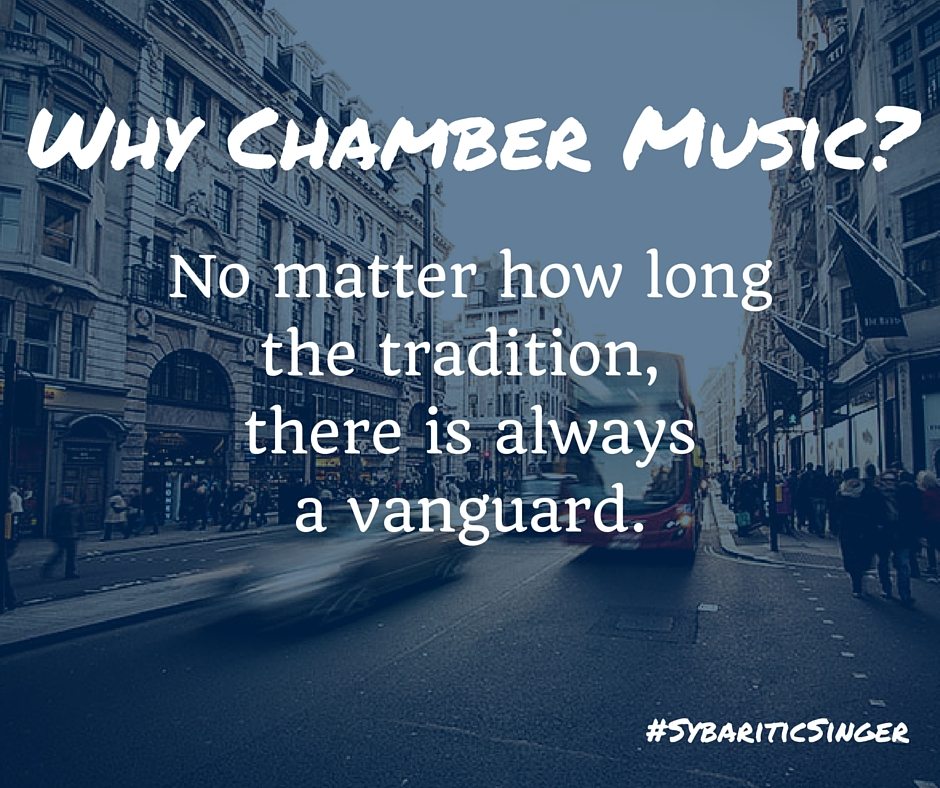In the current season of the NPR-affiliated podcast, Serial, Sarah Koenig at one point describes the idea of the entire US Military searching for a single captured soldier — calling the military’s tanks and jeep caravans “this big machine that’s moving around […] and there’s a mouse running through the legs of the machine.” The forces who had captured this soldier had the benefit of mobility, could skirt around on back roads with motorcycles, could operate more freely at night, could disguise themselves more effectively. There was no match between hunter and quarry — a square peg for a round hole.
A bit of a heavy-handed metaphor to conjure up, I admit, but this comparison conveniently superimposes onto my concept of chamber music — and especially onto one aspect of its value: flexibility.
Why Chamber Music? Because chamber ensembles are the flexible vanguard of classical music.
I’m far from believing the scare-tactic reports of classical music’s impending death, but it’s important not to ignore the more important, more pointed cries: that classical music serves the primarily the elite in its programming, in its locales, in its subject matter, and in its representation. Those cries ring painfully true — and while it’s one thing for diverse groups to seek out and perform music by diverse composers, where does audience diversity play into this? Enacting change in your practices and ensemble are tremendous steps that should be taken seriously, but making those changes apply a step further — bringing broader and more diverse performances to broader and more diverse audiences — is much more nuanced and elusive.

Chamber music, for me, is the primary format in which to conquer this difficult second step. Large ensembles can enact grand change, as well — by offering diverse works, by providing cheaper tickets to younger audiences, by inviting scholastic groups to attend, by holding workshops, et al. — but their actions are primarily restricted by size: they must operate out of their grand hall(s), and most of these opportunities consist of inviting outsiders into the hall. It’s less hunting and more trapping — both effective, both allow you to eat, but certain, larger, worthwhile things cannot be caught by trapping.
Chamber musicians are those who can hunt — not tied to a large venue, they can operate in many locations and perform for many audiences and, most importantly, can more pointedly seek out new and diverse audiences where they are (rather than demanding that they operate on our terms.) Data from Chamber Music America “suggests that small organizations — those with a budget of $154,000 or less — are primed for deeper engagement with their audiences” — and this penchant for impact should not be ignored.
Small organizations are primed for deeper engagement with their audiences.
It does not require a grandiose orchestral experience to make a music fan out of any audience member; I’ve witnessed the genesis of strong, loyal opera fans from performances of opera in tiny venues accompanied by piano or string trio. The size and grandeur of the gesture matters significantly less than the gesture itself: you’re bringing stories to them, you’re telling them to people who have never heard them before. All ensembles should approach outreach in a way that behooves their organization, but an axe is an axe and a spade is a spade — chamber music is, by nature, perfectly suited to multi-faceted outreach, and the future generations of musicians and music consumers will benefit from chamber musicians embracing and acting upon these undeniable proclivities.

Griffin Candey (b. 1988) is an American opera composer dutifully committed to creating vocal and theatrical works that, in approaching forward-looking subject matter, aim to both expand and preserve these genres. Experienced as an opera singer,Candey’s vocal music retains a level of practical vocal finesse that its interpreters praise for its “prosody that showcases both the words and the singers,” its “intuitive rhythm,” and its “lyricism and emotional depth.”

